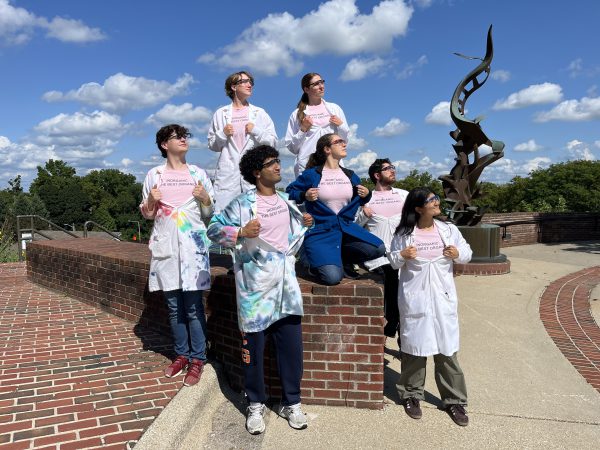At the College’s annual Community Breakfast on October 1, Kalamazoo College President Jorge G. Gonzalez highlighted the dynamic relationship between the College and the city of Kalamazoo, focusing on the contributions of K students and the shared successes fostered through local partnerships. The event brought together leaders from nearly 40 organizations, including state and local officials, business professionals and nonprofits, all committed to strengthening these vital community connections.
Gonzalez recapped some of the College’s 2024 achievements and emphasized that Kalamazoo College continues to attract outstanding students from across the United States and around the globe, as well as from the local area.
This fall, the College welcomed 314 first-year students and 24 transfer students from 16 states and 10 countries. Diverse in academic interests and passions, he noted that 31 percent of the first-year class is comprised of domestic students of color, 30 percent are Pell Grant eligible, and 25 percent are first generation college students. Among the College’s 1,335 total students, K counts 90 Kalamazoo Promise Scholars and 28 Heyl scholars; last June the College graduated its largest Promise cohort since joining the list of participating Michigan higher education institutions.
Gonzalez highlighted the many ways that K students become an integral part of the Kalamazoo community, working in local businesses, volunteering in schools and participating in community projects. He cited Professor Amy MacMillan’s Principles of Marketing class, which is working this fall with Greenleaf Hospitality Group to build student awareness and interest in their businesses as a potential employer after graduation. He also cited the nonprofit organization Building Blocks of Kalamazoo, which promotes vibrant neighborhoods through resident-led group projects. Originally founded by Professor Emeritus Kim Cummings, Building Blocks is now led by Kalamazoo College alumna Katie McPherson ’08, who as executive director, continues to foster this partnership through summer internships, volunteer opportunities and collaborations with faculty.
Another highlight of K students’ civic engagement is its partnerships with the City of Kalamazoo. City Planner Christina Anderson ’98 is leading the strategic planning process for Imagine Kalamazoo 2035, kicking off with a community read of the book Happy City: Transforming Our Lives Through Urban Design, an activity supported by the City’s outreach and engagement intern, K senior Emerson Wesselhoff.
“The relationships formed through these community projects are transformational,” Gonzalez said, “not only for our students, but for the entire community.”
He also noted that K is proud to stand alongside Western Michigan University and Kalamazoo Valley Community College “as part of Kalamazoo’s vision to be an education city.”
After Gonzalez’s remarks, senior Alex Nam, a double major in international studies and German, spoke about his experiences at K. The flexible curriculum allowed Nam to explore across disciplines, from political science to fundamentals of acting. During study abroad in Germany, he taught English at a local business school through an internship. His involvement in the Mary Jane Underwood Stryker Center for Civic Engagement and the Center for International Programs led him to tutor students at Kalamazoo Central High School through the Refugee Outreach Collective. He also taught German lessons at Woodward elementary school with the German department and most recently, he interned at Read and Write Kalamazoo. He told the audience that while he was born in Louisiana, and has lived in Los Angeles, Houston, and Connecticut, after four years at K, he now considers Kalamazoo his home.


Of his experiences at K, he said, “I saw first-hand how important it was for higher-ed institutions to be closely connected to the communities that sustain them. From tutoring refugee students, to gaining substantial behind-the-scenes pedagogical experience at a non-profit, the robustness of my teaching resume is a testament to the access that K College ensures for its students and the weight placed upon community engagement and civic help…Although four years at K College may fly by —and as a senior I can testify to this—my teaching experiences have made me feel more connected to this community—my community—than I have anywhere else in my life.”
























